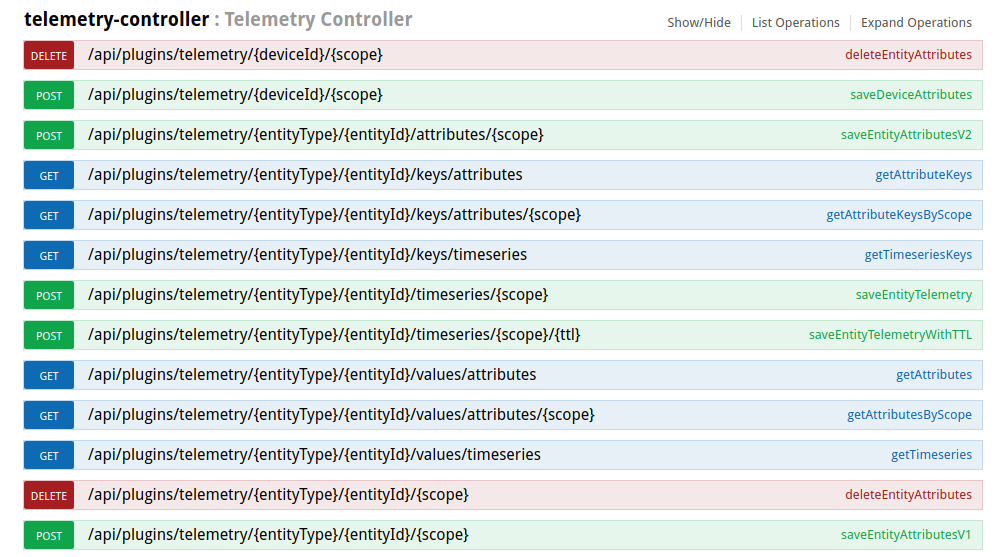Working with telemetry data
ThingsBoard provides a rich set of features related to telemetry data:
- collect data from devices using MQTT, CoAP or HTTP protocols.
- store timeseries data in Cassandra (efficient, scalable and fault-tolerant NoSQL database).
- query latest timeseries data values or all data within the specified time interval.
- subscribe to data updates using websockets (for visualization or real-time analytics).
- visualize timeseries data using configurable and highly customizable widgets and dashboards.
- filter and analyze data using flexible Rule Engine (/docs/user-guide/rule-engine/).
- generate alarms based on collected data.
- forward data to external systems using Rule Nodes (e.g. Kafka or RabbitMQ Rule Nodes).
This guide provides an overview of the features listed above and some useful links to get more details.
Device telemetry upload API
ThingsBoard provides an API to upload timeseries key-value data. Flexibility and simplicity of key-value format allow easy and seamless integration with almost any IoT device on the market. Telemetry upload API is specific for each supported network protocol. You can review API and examples in corresponding reference page:
Telemetry Service
Telemetry Service is responsible for persisting timeseries data to internal data storage; provides server-side API to query and subscribe for data updates.
Internal data storage
ThingsBoard uses either Cassandra NoSQL database or SQL database to store all data.
A device that is sending data to the server will receive confirmation about data delivery as soon as data is stored in DB. Modern MQTT clients allow temporary local storage of undelivered data. Thus, even if one of the ThingsBoard nodes goes down, the device will not lose the data and will be able to push it to other servers.
Server side applications are also able to publish telemetry valued for different entities and entity types.
Although you can query the database directly, ThingsBoard provides set of RESTful and Websocket API that simplify this process and apply certain security policies:
- Tenant Administrator user is able to fetch data for all entities that belong to the corresponding tenant.
- Customer user is able to fetch data only for entities that are assigned to the corresponding customer.
Data Query API
Telemetry Service provides following REST API to fetch entity data:

NOTE: The API listed above is available via Swagger UI, please review general REST API documentation for more details. The API is backward compatible with TB v1.0+ and this is the main reason why API call URLs contain “plugin”.
Timeseries data keys API
You can fetch list of all data keys for particular entity type and entity id using GET request to the following URL
http(s)://host:port/api/plugins/telemetry/{entityType}/{entityId}/keys/timeseries
resources/get-telemetry-keys.sh |
|---|
|
resources/get-telemetry-keys-result.json |
|---|
|
Supported entity types are: TENANT, CUSTOMER, USER, DASHBOARD, ASSET, DEVICE, ALARM, ENTITY_VIEW
Timeseries data values API
You can fetch list of latest values for particular entity type and entity id using GET request to the following URL
http(s)://host:port/api/plugins/telemetry/{entityType}/{entityId}/values/timeseries?keys=key1,key2,key3
resources/get-latest-telemetry-values.sh |
|---|
|
resources/get-latest-telemetry-values-result.json |
|---|
|
Supported entity types are: TENANT, CUSTOMER, USER, DASHBOARD, ASSET, DEVICE, ALARM, ENTITY_VIEW
You can also fetch list of historical values for particular entity type and entity id using GET request to the following URL
http(s)://host:port/api/plugins/telemetry/{entityType}/{entityId}/values/timeseries?keys=key1,key2,key3&startTs=1479735870785&endTs=1479735871858&interval=60000&limit=100&agg=AVG
The supported parameters are described below:
- keys - comma separated list of telemetry keys to fetch.
- startTs - unix timestamp that identifies start of the interval in milliseconds.
- endTs - unix timestamp that identifies end of the interval in milliseconds.
- interval - the aggregation interval, in milliseconds.
- agg - the aggregation function. One of MIN, MAX, AVG, SUM, COUNT, NONE.
- limit - the max amount of data points to return or intervals to process.
ThingsBoard will use startTs, endTs and interval to identify aggregation partitions or sub-queries and execute asynchronous queries to DB that leverage built-in aggregation functions.
resources/get-telemetry-values.sh |
|---|
|
resources/get-telemetry-values-result.json |
|---|
|
Supported entity types are: TENANT, CUSTOMER, USER, DASHBOARD, ASSET, DEVICE, ALARM, ENTITY_VIEW
Websocket API
Websockets are actively used by Thingsobard Web UI. Websocket API duplicates REST API functionality and provides the ability to subscribe to device data changes. You can open a websocket connection to a telemetry service using the following URL
ws(s)://host:port/api/ws/plugins/telemetry?token=$JWT_TOKEN
Once opened, you can send
subscription commands and receive subscription updates:
where
- cmdId - unique command id (within corresponding websocket connection)
- entityType - unique entity type. Supported entity types are: TENANT, CUSTOMER, USER, DASHBOARD, ASSET, DEVICE, ALARM
- entityId - unique entity identifier
- keys - comma separated list of data keys
- timeWindow - fetch interval for timeseries subscriptions, in milliseconds. Data will be fetch within following interval [now()-timeWindow, now()]
- startTs - start time of fetch interval for historical data query, in milliseconds.
- endTs - end time of fetch interval for historical data query, in milliseconds.
Example
Change values of the following variables :
-
token - to the JWT token which you can get using the following link.
-
entityId - to your device id.
In case of live-demo server :
- replace host:port with demo-thingsboard.io and choose secure connection - wss://
In case of local installation :
- replace host:port with 127.0.0.1:8080 and choose ws://
resources/web-socket.html |
|---|
|
Data visualization
ThingsBoard provides the ability to configure and customize dashboards for data visualization. This topic is covered in a separate guide.
Rule engine
ThingsBoard provides the ability to configure data processing rules. Each rule consists of
- filters - to filter incoming data feed,
- processor - to generate alarms or enrich incoming data with some server-side values
- action - to apply a certain logic to filtered data. You can find more details in a separate guide.
